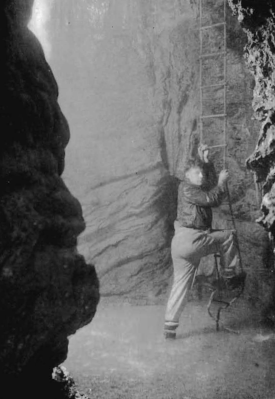UBSS - A Brief History

The Swildon's '40' in 1922. © UBSS.
The history of the U.B.S.S. ought to begin in 1919 when the society was founded, but, as might be expected, this is only half the story. The society’s direct predecessor was known as the Bristol Spelæological Research Society and was formed in the spring of 1912. Its object was to study caves in a more scientific manner than had previously been thought necessary. The Society had four original projects: the attempted reopening of Plumley’s Hole in Burrington Combe; the re-exploration of Lamb Leer Cavern; the measurement of the evaporation in Eastwater cavern and an archaeological excavation in Aveline’s Hole, also in Burrington. This latter cave proved to be very important for the study of early man on Mendip, as the excavation unearthed a large number of Palaeolithic skulls and other bones. The Great War then intervened and no more work was done until the B.S.R.S. members returned from their war service. In view of the obvious importance of Aveline’s Hole, the landowner, George (later Sir George) Wills, decided that any further investigation should be done under the auspices of the University and so the U.B.S.S. was formed. As only one member of the B.S.R.S. was at the University at the time, the rules for membership of the society allowed for the election of outside members, and uniquely among caving clubs at that time, women joined on an equal footing with men. The original objectives of the U.B.S.S. were “the discovery of caves and the examination of their contents”. However, since 1919, other objectives have been added - all contributing to the present varied nature of the society - which include: archaeological excavations; the development of a museum and library; (the Stables) the holding of regular lectures, known as Sessional Meetings and the establishment of our Field Headquarters in Burrington. The Society is virtually unique, in that it has always allowed the election of former students and ‘outside’ members. This means that we have a large number of experienced members on hand to assist with our activities and training, in particular, leaders for various caves. The U.B.S.S. is affiliated to the Students Union and has always enjoyed a great number of benefits from this, in particular the use of the tackle store. Since its foundation, the Society has endured many moves, including one during the war when both the library and the museum were destroyed by incendiary bombs. We have received grants from the Student Union to help with the tackle, travel and the library, and also from the University to help with publishing ‘Proceedings’, a scientific journal with a world-wide circulation.
Probably the oldest ‘member’ of the society still present is our Hut, or Field Headquarters. Its history dates back beyond living memory as it started as a ladies’ cricket pavilion at Bower Ashton and was bought for the society by our first president, Professor Edward Fawcett, for £5. It was dismantled on 31st December 1919, transported to Burrington on the back of a lorry, at a cost of 30/- and reassembled in a field belonging to George Wills.
But daylight was fading and it was snowing when the roof was put on. This led to it being done in a hurry and the roof went on a bit crooked. It still is! Over the years, the Hut has been extended, modified and even modernised. Visitors can now enjoy such luxuries as hot and cold running water, electric-lights and an open fire. We also have caves, albeit small ones, right on our own doorstep.
Early Log Books
Most of the Society’s fieldwork has been recorded in a series of logbooks, dating back to the very beginning of its history. Some of these have been lost, either they did not survive the war, or they went astray at later periods, but the remaining ones paint a vivid picture of our activities, both serious and otherwise, over the years. Copies of the earliest surviving examples can be found here (Some of these files are very large):
- Log 1926 - 1930 General Log IV The only pre-war log to survive the Blitz.
- Log 1939 - 1943 Camp Log “0” Preserved for a long time by the late Rodney Pearce.
- Log 1943 - 1946 Camp Log “1”.
- Log 1946 - 1947 Camp Log “2”
- Camp Log “3” was lost before 1968.
- Log 1948 - 1949 Camp Log “4”
- Log 1949 - 1951 Camp Log “5”
- Log 1951 - 1953 Camp Log “6”
- Log 1953 - 1955 Camp Log “7”
- Log 1955 - 1957 Camp Log “8”
- Camp Log “9” was lost before 1968.
- Log 1958 - 1960 Camp Log “10”
- Log 1960 - 1961 Camp Log “11”
- Log 1961 - 1962 Camp Log “12”
- Log 1962 - 1963 Camp Log “13”
- Log 1963 - 1964 Camp Log “14”
- Log 1964 - 1966 Camp Log “15”
The then known extant logs were indexed by T.R. Shaw in 1968. Although not complete, it is the only index that currently exists. A copy may be found here.
